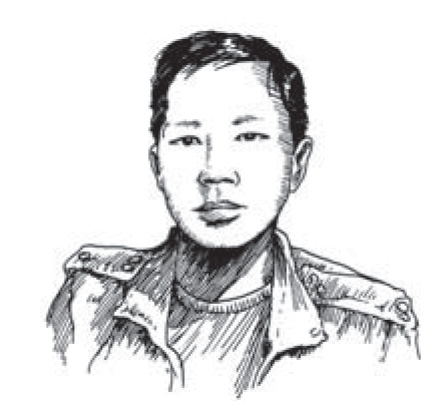The second time I meet Paul Chan at his Brooklyn studio, there’s a small earthquake. The couch we’re sitting on shakes. Chan gets up and looks around. People have left the large warehouse in New York where he works, and are standing on the streets. So we evacuate, wait, and, after nothing happens, go back indoors. On the way up to his studio, Chan offers a suggestion for this interview. “Say that I caused the earthquake,” he says. “We were talking about friendship, or men, and suddenly my eyes turned bright green and I started speaking Aramaic.”
This kind of joke is characteristic of Chan, who’s made himself known as a sort of art-world trickster. Born in Hong Kong, he moved to Omaha (“the birthplace of Malcolm X and also Ed Ruscha”) as a child partly because the Hong Kong air was making him sick. He attended the School of the Art Institute of Chicago and then Bard College, where he earned an MFA. Chan’s art treats political subjects in lyrical, often incongruous ways. In 2002, he traveled with an American aid group, Voice in the Wilderness, to Iraq, where he filmed Baghdad on the eve of the Iraq War—intimate scenes of cafés and interviews with the city’s residents. His collection of poetic shadow projections, The 7 Lights, premiered at the Serpentine Gallery in London in 2007, and he gained national prominence later that year for a staging of Waiting for Godot in post-Katrina New Orleans. His last exhibit, a nearly six-hour video projection entitled Sade for Sade’s Sake, was shown in 2009 at the Venice Biennale and at Greene Naftali Gallery in New York.
Recently, he’s turned his attention away from exhibitions and toward publishing books, starting one of the first, and certainly the most lewd, houses devoted solely to artistic e-books. Among the projects is a series of fonts Chan made in conjunction with his Sade exhibition that transform any piece of writing into a filthy text. He’s been applying the fonts to Plato and John Maynard Keynes.
We spoke twice in his three-room studio, eating almonds and stale sour candy.
—Madeleine Schwartz
I. CARROT
THE BELIEVER: How long have you been in this space?
PAUL CHAN: Two and a half years.
BLVR: It’s nice! It’s a nice area!
PC: There’s a Costco… and an IKEA. The only batting cages I’ve ever seen are five blocks away. I went once with Cory [Arcangel, another artist, who works downstairs]. It was fun. And I will probably never go again. I actually don’t like baseball. I don’t know why I went.
BLVR: That’s very un-American.
PC: One thing I don’t like about professional baseball is that now they wear slacks to play. Before, they wore uniforms that exuded a look of athleticism. Now, it’s more like casual Fridays.
BLVR: Tell me about this publishing venture.
PC: I always wanted to publish books but I never had the money. I also never had the time. And so, after my last show, in 2009, I quit making art. It was time. I stopped making new work, and I stopped taking on opportunities to show my works. I essentially retired. Two years go by and I thought, Well, I’ve got to do something besides cleaning my studio floor and doing odd jobs. At that time, e-books were just coming out. The Kindle started to be sold. The iPad was making a splash. E-books seemed like a viable format for people who were interested in reading. And the world of e-books was not, to me, aesthetically interesting or experimental in form. So I thought, Maybe I can make e-books? That’s how Badlands Unlimited started. And a year later we’re still making books. We kick out artist books, my books, other people’s books. It’s a lot of work. There’s no money. We have two mottos. The official one is “We make books in an expanded field.” The unofficial one is “We lose time and waste money.” Whichever you prefer.
BLVR: Retirement seems to be a hip move. People have been talking about Peter Nadin, who had his first show in decades after starting his own farm upstate. Is that part of your plan?
PC: There is no plan. I wanted to do nothing in particular, exhibition-wise. The old work gets shown. I’ve turned down most opportunities to do anything, because I wanted more than anything else the thing one can never have enough of: time. It is of course wonderful and gratifying to have shows and exhibitions and to travel and partake in the excitement that makes contemporary art interesting. And then you realize that a carrot isn’t a carrot. A carrot is a stick.
BLVR: Peter Nadin said in a New York Times article that a carrot is a work of art.
PC: He really likes carrots, doesn’t he?
BLVR: Do you have an audience in mind when you create work?
PC: I make things to hold my own attention. Barnett Newman was right when he said he makes paintings so that he has something to look at. In many ways, making work is a testing ground for what it means to pay attention: what can I make that will hold my own attention, so that the time spent being attentive is not wasted? To imagine that I can make something that would experientially be the same for me as it is for you is a nice wish, but it’s only that. But what I can do is make the experience singular enough for me so that at the least it holds my attention.
BLVR: You reference so many other thinkers and artists in your work: Sade, Adorno, Beckett. Do you feel that you are sharing anything when you discuss them or when you include them in your art?
PC: Am I sharing? [Pause] Have you ever read something that doesn’t make sense but still holds your attention?
BLVR: Yes.
PC: What about it holds your attention?
BLVR: The promise that I will one day understand, and the idea that there’s an internal logic that holds the work together, of which I can get only glimpses.
PC: Those glimpses that you feel are the closest we have to the sharing you talk about. And those glimpses provide just enough illumination for us to see something unfold without it being spelled out. It can’t be spelled out, because it takes us to do the spelling.
II. STAY OUT OF JUVIE
BLVR: No one’s been very good at making e-books for art.
PC: Technically, it’s an issue because of screen resolution. Also we are used to art books being bigger than regular reading books, but you can’t change the size of an e-reader. These constraints point the way forward.
BLVR: What have you been working on recently?
PC: This fall, Badlands is publishing On Democracy by Saddam Hussein. In the late ’70s, when Hussein was vice president of Iraq, he delivered three speeches on the subject of democracy. They are politically perverse but eerily prescient, given what seems to be common knowledge now, that democractic countries aren’t necessarily democratic at all. The book reprints the speeches, along with a set of new drawings by me and essays from journalists and writers reflecting on contemporary notions of democracy in light of what Hussein talks about. This winter we’ll be publishing Marcel Duchamp: The Afternoon Interviews, by Calvin Tomkins. In 1964, Tomkins interviewed Duchamp a number of times at his apartment on West Tenth Street, in New York. The material ended up in Tomkin’s 1965 profile of Duchamp in the New Yorker, and eventually in Tomkins’s great biography of Duchamp. But the interviews themselves have never been published. So it’s very exciting. And just in time, because the onehundred-year anniversary of the first ready-made is 2013.
BLVR: How do you choose what works? Do you hope to advance a particular agenda?
PC: I don’t know what works. I only know what is worth working on. And there is no particular agenda beyond what I want to publish. Last year Badlands published choreographer and filmmaker Yvonne Rainer’s first book of poems. And this came up because I’m friends with Yvonne and we were emailing one day and I wrote, “Is there anything that you haven’t published?” She’s published scripts and essays before. She said, “Yes, poems.” Seven months later, we have a book. And what is attractive about publishing her is precisely that she’s not known as a poet. Maybe there is an attractive symmetry, because I’m barely a publisher. I call it my Halloween costume. So in a way neither of us knows what we’re doing. But in not knowing, we can potentially do something other than what has worked before. Something else.
BLVR: Was part of starting a publishing venture its cheapness? So many more people can participate and get access to the work.
PC: That’s part of it. The other part is that I thought Badlands would concentrate on making e-books so we wouldn’t have to spend money printing paper books. It turns out that that is not the case. We now spend double the amount [that we would printing books]. Which is not the worst thing in the world—it makes us like most presses, I suppose. We are a no-profit company as opposed to nonprofit.
BLVR: What was the first work you remember feeling moved by?
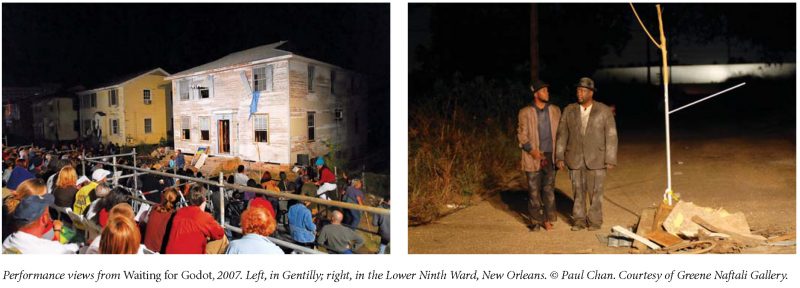
PC: I was sixteen and was living in Omaha at the time. And this small experimental theater put on a show of three short plays by Samuel Beckett. For some reason, I thought it was a good idea to bring a date to this. So we went. There were exactly two other people in the audience. But it was sublime: that feeling of not knowing what you were looking at, but feeling that you had to pay attention, that somehow through its composition you’d been captured by it. It felt as if it was a form of unreason that made all the reason in the world unreasonable.
BLVR: Is that the feeling you try to command in your work?
PC: The short answer is yes. The long answer is no.
BLVR: Were you thinking you wanted to be an artist at the time? Were you really inspired to do theater?
PC: I, like most people, I imagine, didn’t know what I wanted to do at sixteen. I just wanted to drive a car and have sex and stay out of juvie. Besides, Beckett is much more than theater. When I delved into his work, I began to see others he was entangled with, other playwrights, like Pinter and Ionesco, for instance. And then the circle widened to writers and poets, to Mallarmé, Joyce, and Stein. I saw not only the artist but his aesthetic milieu.
BLVR: Do you wish you were in a similar group of artists?
PC: No. Beckett himself escaped it, you know.
BLVR: So no art-world friends. What about enemies?
PC: [Laughs] I like what William Blake wrote, “Opposition is true friendship.”
III. NEVER COMIC SANS
BLVR: The Marquis de Sade is best known for the sex in his work, but as you’ve noted, he was also a political thinker. In using him in your work, were you trying to redeem his reputation?
PC: His reputation is the last thing that needs redeeming. What I was interested in was how Sade’s work captured for me a certain mood and line of thinking that was present in the times. No other body of work illuminates more starkly the entanglement of sex, reason, law, and freedom. Sex in Sade is obvious only insofar as it is not simply about sex. No one else has created work in such a way that makes the idea of sex almost impossible to disentangle from those other notions. We want our sex to be disentangled and purified, for sex to somehow simply be sex. But to separate sex from those other notions that it naturally responds to and is sharpened by distorts what it essentially is. Most commercial pornography, for example, is the expression of disentangled sex. What is being portrayed is sexual engagement that is disengaged from the other elements that make sex pleasurable, troubling, and enigmatic. It is the image of sex as a form of alienation.
BLVR: You’ve said that sex is its own form of reason.
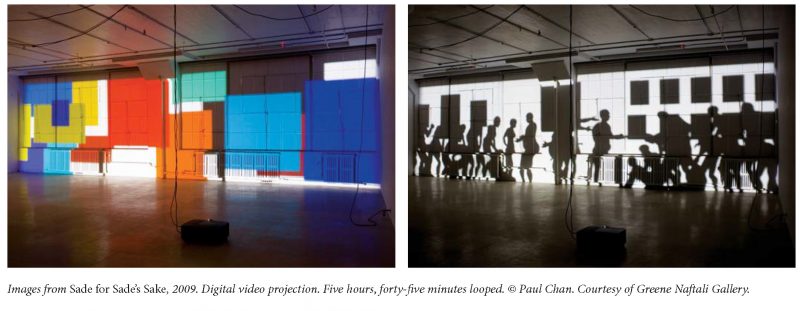
PC: There’s a kind of causality in sex that one can follow over time. It leads us. It has its own logic that is neither rational nor predictable, but we can’t call it irrational. It follows a consistency. Look at the sexual scandals politicians in the U.S. have been embroiled in over the last couple of years: they’re laughably consistent, the way sex has been used and abused. In many ways, it’s great that sex is its own reason. It’s great because it sows doubt about the dominant form of reason.
BLVR: Is this what you’ve been trying to show in your Sade project? One of main components is a series of fonts that you created that turn anything you write into sex sounds, basically.
PC: To me, the fonts—there are nineteen of them—crystallize what we’ve been talking about in the form of fonts that don’t function like any other font I’m aware of.
BLVR: Because it makes whatever you type sound like sex?
PC: More and less. Sade’s writing has been described as unreadable in part because of its formal structure. The sheer repetition of scenes, of perversities, of character plots that are literally plodding. It doesn’t move like a story ought to move. But this is because it moves at the pace of compulsion. And that in many ways makes it as unreadable as what he is actually depicting.
This force of compulsion in the form of repetition is precisely Sade’s formal way of inhabiting this idea of sex— it is literally sex as a form. Here is an example. Say “yes” to somebody once, and it’s just a “yes.” But say “yes” over and over, and while you’re at it, change the rhythm and intonation and your breath as you say it (and don’t forget to look them in the eyes), and I imagine that somebody you’re saying it to will slowly start to blush. Parts may even get hard, or wet, or both. The fonts generate a kind of disembodied eros through this compulsive repetition. It’s hard to show the fonts or even talk about them, because the real pleasure comes from you typing with them. They are literally sensuous.
BLVR: I have never heard typing described as a sensuous experience.
PC: Maybe you just haven’t used the right font. You won’t get there using Times New Roman. And certainly never Comic Sans.
IV. PUBLIC ATTENTION IS NOT AN ABSOLUTE GOOD
BLVR: What kind of art will come from the war on terror?
PC: Perhaps the kind Kafka wanted his work to feel and act like: an ice ax breaking the frozen sea inside us. One of the things that happened during the war on terror was that there was a feeling that we needed to protect ourselves in such a way that we became someone else. In many ways, that feeling of protection stopped us from being fully developed. Let’s hope that the work that is made around or after will help us not feel so protected.
BLVR: You’ve said what you would want; what about what you think will come out?
PC: What’s the difference? You always hope that what you think will come to fruition.
BLVR: Have you been working on any political projects?
PC: None that I want to talk about. I’ve said in interviews before how I’ve kept my art and activism distinct, if not altogether separate. One of the reasons I do that is because as an artist people think that whatever you do is supposed to be art. Or at the least, that is what artists want you to think. I just don’t care to believe that. There are many things I do that may not be art at all. But they are equally as important. The have their own kind of dignity. The political work is most political when it’s political work. That’s why I keep those activities distinct from what I’m more known for doing.
BLVR: Are they just causes or things worthy of action if you’re not willing to talk about them in public?
PC: It’s just a constant negotiation. The way in which I’ve worked tends not to benefit from the glare of attention or media, which sometimes brings more harm than good.
BLVR: How so?
PC: Sometimes the attention becomes an impediment to achieving a political goal; for instance, when political campaigns confuse organizing with public relations. As an example, the group I went to Iraq with, Voices in the Wilderness, now known as Voices for Creative Nonviolence—they’ve been doing it since the first Gulf War. They organize on a certain scale specific to who they are, in such a way that keeps the work grounded. They have focused for nearly two decades on the plight of Iraqis caught in two wars brought on by the U.S. And, of course, it would be progress if more people agreed with what Voices represents. But if Voices concentrated on making more people agree with them, there wouldn’t be enough energy to do the actual organizing. To me, that is something I would rather be involved than anything that would use public attention as a tool or weapon. Because I think public attention is not an absolute good.
BLVR: Are you worried about influences going the other way—your politics affecting your art negatively?
PC: They will always inform each other in ways that are unpredictable. That’s a given—I’m the same person doing it. But to see them as one and the same is to do a disservice to both. I engage in art for different reasons than I engage in politics. They may overlap, but they are essentially distinct, perhaps because they are—if, in fact, they are what we say they are—expressing fundamentally different models of what it means to live with others and how to be oneself.
BLVR: So do you look down upon artists who engage actively in topical debates in their work?
PC: If art is art, it makes us see that topical debates are neither topical nor really a debate. It’s like—have you ever read those stories about how people produce bioelectricity? And that some of us produce more bioelectricity than others, enough so there is a strong-enough electromagnetic field that it disrupts electronic devices, like cell phones and computers? I like to think sometimes that art is a thing that produces a kind of charge that makes nothing work. Then we can look at these things that don’t work and decide whether they are in fact worth their weight for us.
BLVR: It seems to me that your work is increasingly stripped. From your early video work, which had so many layers of images, to the empty shadows in Sade. Now you’ve begun taking apart books and painting their covers.
PC: In many ways, I always start with too much. The aesthetic challenge is to reduce. Even if I start with an empty page or a blank video-projection, it’s already too much. Composing, drawing, and animating are all methods of reducing.
V. HAMSTER DANCE
BLVR: I’ve been reading about spite fences—when people put up large hedges around their houses to annoy their neighbors.
PC: Sometimes I think people put up spite fences in their mind. They don’t want anyone to look in. It’s the opposite of what Adorno said: curiosity is “the pleasure principle of thought.”
BLVR: You write a lot about Adorno. I’ve wondered about how Adorno hated television, like, so much! Do you think he would have liked video projections?
PC: Adorno by all accounts didn’t like much—except perhaps Beethoven, early Schoenberg, and certain works by Francis Bacon. And, of course, Samuel Beckett. He was holding out for the kind of art that he believed could genuinely be called art.
BLVR: What was that?
PC: He believed that art was the form that could potentially show us how reason is unreasonable. And in doing so would provide a clearing for us to find a way out of the mess of it all.
BLVR: One could say that your work possesses different ways of dismantling a particular kind of reason.
PC: That’s a nice way of putting it. A friend who is a philosopher once said to me, “Reason is nice, but have you met reasonable people? They are just the worst. You don’t want to talk to them. They are just too damn reasonable!”
BLVR: Is this dismantling of reason a different way of making a critique? After all, a work can’t really be a critique if it’s using the same language as its object.
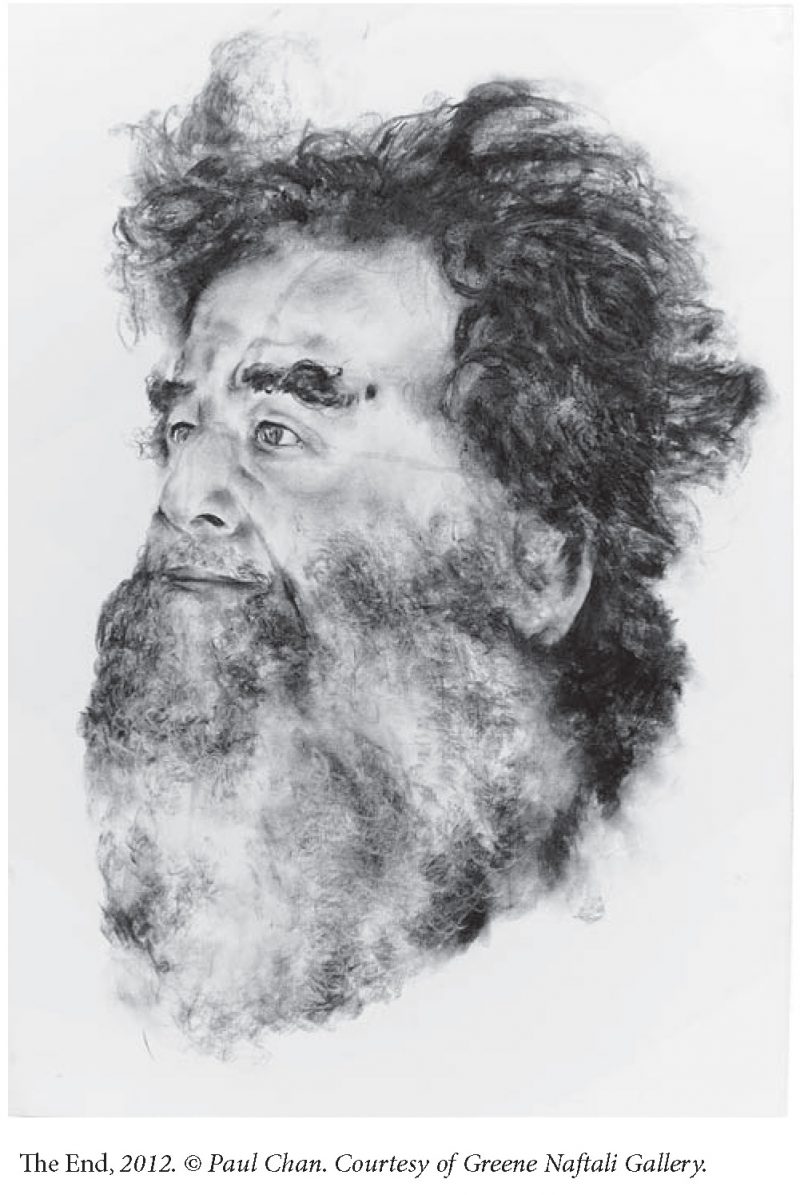
PC: If art is indeed art, it is a non-judging kind of judgment. By virtue of artworks merely existing, it becomes a kind of judgment on all the other things that exist that have been distorted and marred and weaponized for the benefit of a kind of social progress that is anything but. Artworks don’t have to say anything in particular, or do anything in particular, to be a kind of critique.
BLVR: After your Lights series came out, you were referenced as a 9/11 artist. Did you get worried about being pigeonholed? From that project to Godot seems like such an abrupt shift.
PC: From my standpoint it wasn’t an abrupt shift at all. I thought of it as a continuation of what I was interested in by other means.
BLVR: When you did your project in post-Katrina New Orleans, were you trying to make people care?
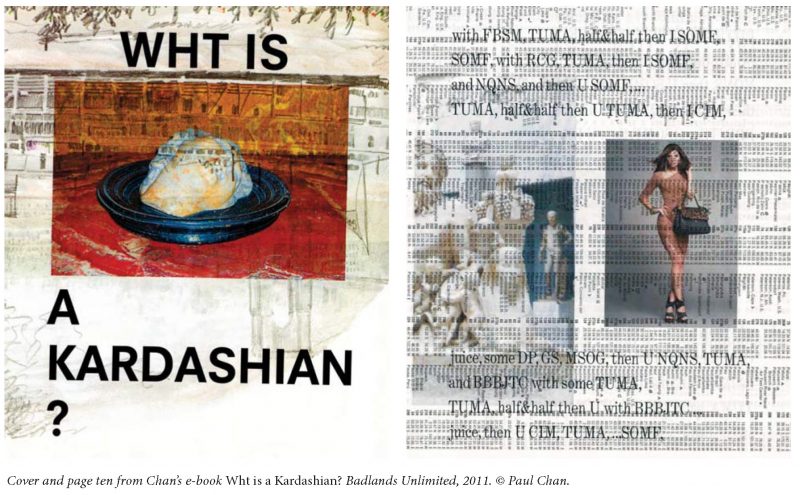
PC: Making people care was never the point, and probably will never be the point of what I do. Doing something as specific as possible for that place and time is closer to the point. I was doing it so whatever ended up being done had to happen there. And in order to do it that way, one had to pay attention every day, every minute.
BLVR: How do you make people care?
PC: Mayor Bloomberg in New York tried to pay parents in certain neighborhoods to bring their kids to the doctor. He wanted to bribe parents to care. Apparently the plan didn’t work. I have a hard enough time caring myself that I would not know the first thing about making other people care about whatever it is I think they ought to care about. But it seems to me the real question is: how does one come to care? In my experience, it was curiosity that made me care.
BLVR: Do you view your work as being helpful?
PC: Not in the least.
BLVR: How so?
PC: There are many ways to be helpful. I hope that the work is none of those.

